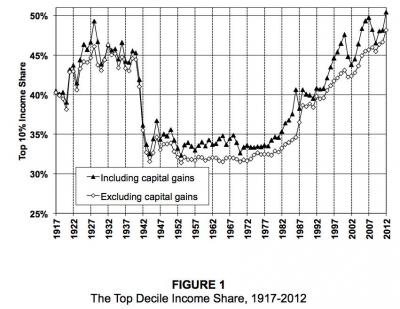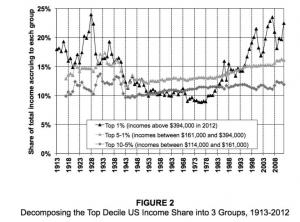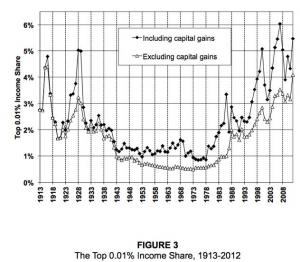By: Robert D. Putnam
Simon & Schuster, 2015. 400 pp. Hardcover, $28.
The American Dream, that fantasy of growth that has long girded the ideology of entrepreneurship and a better future, is in crisis. Many haven’t felt the dream for decades, some never having experienced it at all. Robert Putnam, in his latest work, Our Kids, seeks to confront this stagnation in our economic dreams by interrogating the forces that have taken hold of communities across the United States. In some ways a continuation of the issues he grappled with in his now famous work Bowling Alone, Our Kids provides a compelling account of the symptoms of inequality manifested in the behaviors, practices, and habits of increasingly unequal populations within the United States.
Our Kids opens with a portrait of Putnam’s hometown of Port Clinton, Ohio, a city which—in the 1950s—embodied the stereotype of the small American town. Port Clinton serves as the example, a town that has gone through the social and political transformations that have shaped the United States up to the present day, to open up Putnam’s discussion of what went wrong. Our Kids springs from the staggering statistics of youth unemployment, the spatial separation of the rich and the poor, and the undermining of the values and community life that, Putnam claims, once defined his hometown.
The author seeks to get at the heart of the inequality debate, while distinguishing between equality of income and wealth on the one hand, and equality of opportunity on the other. In maintaining this traditionally American fixation on equality of opportunity, Putnam asks, “Do youth today coming from different social and economic backgrounds in fact have roughly equal life chances, and has that changed in recent decades?” (31) The text that follows is an exploration from inside out, starting with individuals and their families, to the neighborhoods they grow up in and the schools they attend, pursuing the effects of inequality and how it has manifested itself in cognition, family life, institutions, and space.
Written for a non-specialist audience, Our Kids utilizes a mixed-method approach to investigate its research question. Putnam begins each chapter with a collection of life stories from anonymized characters, chosen as representatives of the great class divide. But behind each story lies a wealth of quantitative data, statistics that take certain segments of the individuals’ life stories and show how their experiences are common occurrences in this new landscape of growing inequality. It is this blending of the individual case with societal trends that represents, in my opinion, the best kind of social science. How do we find the general in the particular?
Putnam is tracing a trend that began in the 1950s when he claims that “the power of race, class, and gender to shape life chances in America has been substantially reconfigured” (18). His findings show the dominance of class in discussions of the variables that have come to define social existence, stating that while “gender and racial biases remain powerful,” there is evidence to show that these divisions are lessening (19). In the twenty-first century, class inequalities are widening, and therefore it is class analysis that forms the backbone of the text.
How does he make this argument? Going back to the theme of equality of income versus equality of opportunity, Putnam contrasts the concepts of absolute and relative mobility. Absolute mobility is experienced during times of growth, when all classes are experiencing increasing standards of living, albeit within their own class categories. Relative mobility—historically a much less frequent form of mobility—is when a child born to lower-class parents can move him or herself into a higher class. When Putnam was a child in Port Clinton, both absolute and relative mobility were high. This was a period when the United States was experiencing an incredible amount of growth due to the post-World War II economic boom. But while research has shown conclusively that absolute mobility has been halted since the 1970s, Putnam wants to focus on relative mobility. He argues that the opportunity gap has widened to such an extent, with both absolute and relative mobility at a standstill, that those who are unfortunate enough to have been born into the underclass are faced with immense challenges in the makeup of their social reality. The story of how inequality has manifested itself into this inescapable trap in the experiences of everyday Americans is the focus of the book.
The data begins with families, drawing on two radically different life experiences from the same town in Bend, Oregon, to illustrate the decline of family life. The reader is presented with a study in contrasts, one that repeats itself in every chapter. On one side of the river lives a family where the parents have university educations, planned their futures according to their finances, held well-paying jobs, and were able to use their resources to help their kids when they needed them most. On the other side lives a poor family, the result of financial hardship, broken homes, drug and alcohol abuse, and other barriers to mobility. Putnam’s focus here is on how family life has been restructured based on class origin.
His evidence demonstrates how the number of less-educated mothers giving birth out of wedlock is rising, while a similar statistic for educated mothers has remained constant. It is not an “uncaused first cause” (79), but ties together with lowered wages, a rising prison population, the sexual revolution, and so on. The consequences are that younger mothers have less time to focus on ways they could improve their economic well-being, resulting in less upward mobility. Here we begin to see Putnam’s conception of social capital in play. A difference in the quality of family life between the upper and lower classes leads to lower-class children having less social capital, seen in the “stable parental support” of the first family example against the “dreadful chaos” of the second (78).
The discussion of family leads into a focus on parenting and child-rearing strategies. Perhaps the most interesting discussion here is how the neural development of children who are born into lower-class households is influenced by their environment. Citing recent research by the National Academy of Sciences, Putnam shows how behavioral and cognitive development that begins to materialize in middle age is present in children as young as 18 months, and often earlier. This leads him to conclude that “the brain, in short, develops as a social organ, not an isolated computer” (110); toxic stress from neighborhood stimuli and parental neglect shape brain chemistry from our earliest years.
The breaking up of family units that lose the ability to socially reproduce because of “bad” parenting influences the communities of which those families and individuals form a part. Putnam’s discussion of schooling shows how cognitively fit children with better-educated parents attend schools and grow up in neighborhoods that have been segregated in such a way as to encourage success only on behalf of the fortunate ones.
It is not my intention in this review to repeat the author. I simply want to show how Putnam’s chapters and argument relate to one another to give a sense of the narrow scope that Putnam is working with in addressing the subjects he puts forward. Putnam presents a constellation of variables, and then discusses how they relate to and reflect each other rather than establishing a first cause. While the raw data is true, and we cannot deny the humanity of the people discussed in Putnam’s cases, there is a problem in how Putnam analyzes the data that goes back to his conception of class and his reliance on his theoretical conception of social capital. Putnam himself claims that his is “a book without upper-class villains” (229), but this is partly because Putnam’s scope is not wide enough to include the “villain” in the picture. It’s this “end of ideology” argument that has become all too familiar; the elephant in the room is that political economy has been replaced by culture.
Part of Putnam’s problem is that his metric for viewing class is based on educational credentials. In other words, for him the great class separation is between those who have a Bachelor’s degree and those who have only attended high school. All of his discussions of class are boiled down to this division; all of his charts illustrate the same scissor pattern showing the divide between upper and lower classes. As an indicator of social class, Putnam prefers looking at education over income, which he argues is “much ‘noisier’ (error-prone or entirely missing) and because when both are available, education is typically the more powerful predictor of child-related outcomes” (44). If modern educational credentials have become the signs by which we assign individuals and classes their status in the social hierarchy, viewing class as defined by education will lead to expressions of social divisions. However, this view of class focuses much more on habits, behaviors, and tastes than on socio-economics, and therefore lacks history.
Putnam’s inspiration for operationalizing class as education stems from sociologist Douglas Massey, who in his work Categorically Unequal, which Putnam cites, argues that education is “the most important resource in today’s knowledge-based economy” (45). This is undoubtedly true, but the question must be: What is the knowledge economy and who is responsible for creating this kind of social map? The term “knowledge economy” is frequently cited along with other related concepts: the “information age,” “globalization,” “post-scarcity,” and so on. These concepts have come to reflect the significant shift in the economic, political, social, and cultural landscape that the United States experienced in the second half of the twentieth century.
The graph in figure 11 is a common sight these days, representing how the income of the top 10 percent of the population has skyrocketed since the 1980s. This is the segment of the population that Putnam has in his sights when demarcating an upper class.

However, when one looks at Figure 2, which subdivides the top 10 percent, it is clear that it is the top 1 percent that has been making the most gains and by the sheer force of their wealth has curved the trend of the top 10 percent upwards. This is even starker in Figure 3, which subdivides further into the top 0.01 percent.


Here we see the historical rise of a really dominant class, which is a much smaller yet incredibly powerful group. It is the enormous wealth increase that was experienced by this top 0.01 percent that has redrawn the class hierarchy, bestowing enormous economic and political power to a group that can utilize that influence to reshape American society to its ends. To put it bluntly, the distinction that Putnam draws between upper and lower classes based on education represents a division in cultural taste and access to resources rather than a separation of classes. An insistence on seeing class through the lens of social capital, rather than economic capital, obfuscates this much starker phenomenon. Putnam’s analysis very opportunistically ignores not only policies but the historical reformation of the transnational capitalist class, including the battles it has waged in the political arena to get us to where we are today and its influence on domestic and foreign policy.
How the U.S. middle class shrank, and how the upper middle class retained its share of resources post-1980 is a discussion worth ten dissertations. I would argue it has to do with the loss of manufacturing jobs and the growth of management positions related to the service, knowledge-based, and financialized economy. The distinction between the lowest classes and the upper middle class is an important issue that Putnam’s research reveals, but he fails to analyze it fully. What’s needed is a discussion of how the social hierarchies have been redrawn and how the space they have come to occupy was created.
The class-as-education model comes from Putnam’s reliance on the theoretical framework of social capital. Social capital is a concept that has been around for a long time and one that has many different definitions. At its core is the idea that social networks and relationships have an intangible value of which an individual can possess varying quantities. Putnam defines it as “informal ties to family, friends, neighbors, and acquaintances; involvement in civic associations, religious institutions, athletic teams, volunteer activities; and so on” (207). However, one cannot really discuss social capital without discussing political economy, since it is political economy that allows for the space and resources that develop the institutions of social capital.
The historical legacy of social capital theorists is much less forgiving. By utilizing theories of domesticated social capital (those that eschew a relationship to political economy), intellectual cover was provided to some of the worst policies of neoliberalism. To be fair, Putnam disagrees with the relationship drawn between social capital and neoliberalism.2 But that did not stop the World Bank from utilizing measures of social capital to legitimize privatization.3 In the geopolitical sphere, social capital has been used as a measure to determine “weak” or “failing” states.4 Following Bill Clinton’s lead, former UK Prime Minister Tony Blair even cited Putnam’s work when introducing New Labour policies.5 These conceptions of social capital reflect an inability to seriously grapple with the instability and suffering produced by neoliberal reform and late capitalism.6
It’s no surprise then that Putnam only briefly mentions some of the economic realities behind his community studies. Port Clinton saw the death of manufacturing. Bend, Oregon, suffered from a huge loss of jobs in the logging industry. His discussion of schools only briefly mentions the struggle of inner-city schools over tightening budgets due to fiscal austerity. And when discussing private for-profit colleges and their bogus degrees, there is only a brief musing on the predatory nature of for-profit institutions.
All this is not to say that Putnam is flat-out wrong. His findings are obviously important, and the variables that he discusses in the social lives of his respondents are related in some way. But it is myopic to think that this transformation has come out of nowhere. The phenomena Putnam is talking about are symptoms of inequality, an inequality that is economic, the result of a class-based political project forged for the interests of a particular class, by a particular class. Putnam’s work is important in showing us the human cost of such a project and the shaping of the underclass that is the harbinger of a new gilded age. However, his focus is too limited for helping us engage in the political struggle needed to oppose it.


Leave a Reply